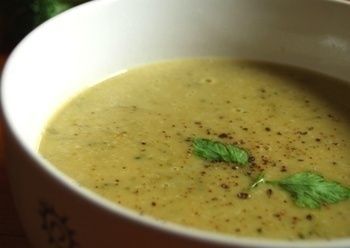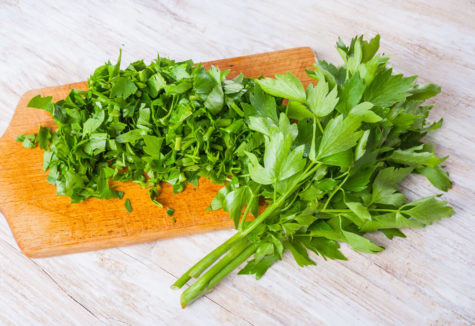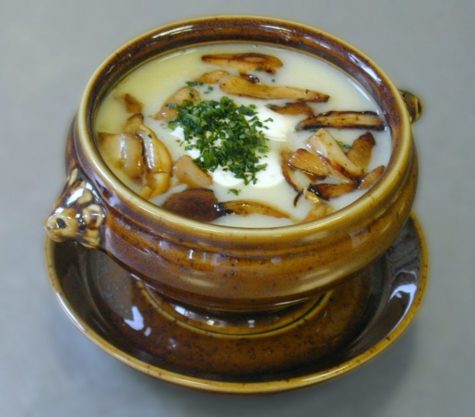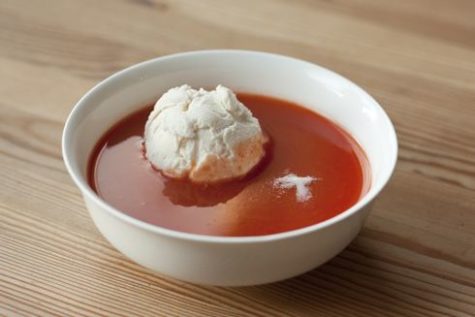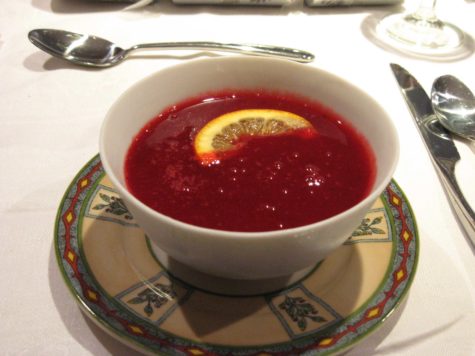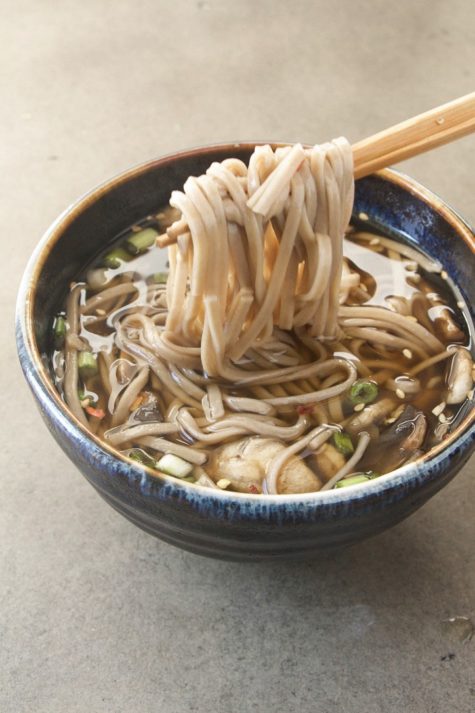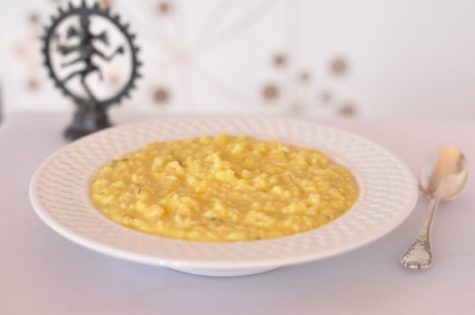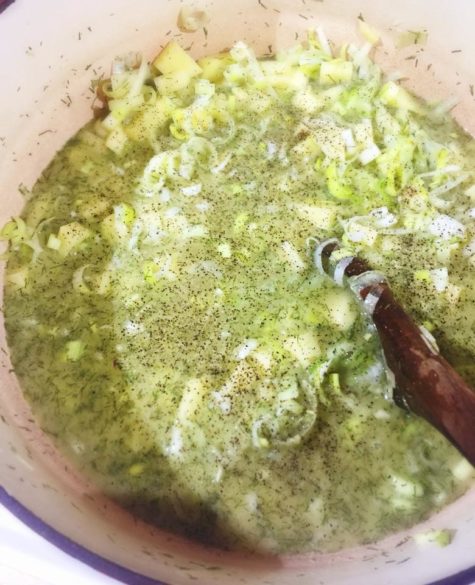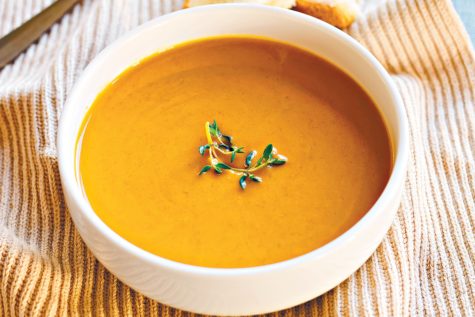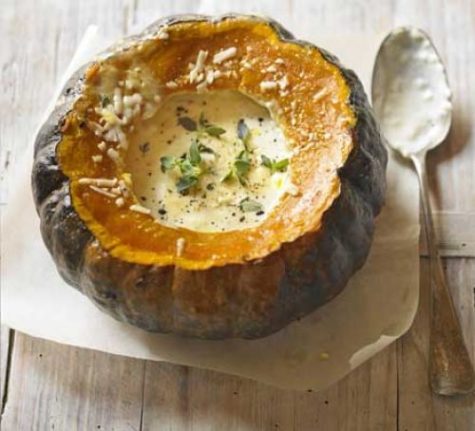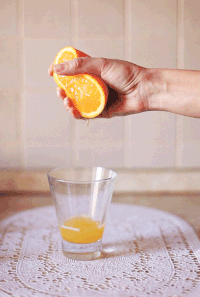Soup
Cream of Alexanders Soup
- 3 tablespoons salted butter
- 1 onion, finely chopped
- 1 clove garlic, minced
- 450 g Alexanders stems and leaves
- 1 Ltr vegetable stock
- 1 tablespoon chopped fresh parsley
- 1/2 tablespoon chopped fresh chervil
- Salt and pepper, to taste
- 150 ml single cream
Melt the butter in a saucepan over medium heat. Add the onion and garlic, cook and stir until soft. Add the Alexanders stems and leaves, toss and coat in the butter, onion and garlic. Cook for 2 minutes. Add the rest of the herbs and stir in the salt and pepper.
Pour in the vegetable stock, and simmer gently over a low heat for an hour. Right before serving, stir in the cream and blend the soup to a smooth consistency with a hand held liquidizer or food processor. Serve immediately in warm bowls.
About Alexanders:
Alexanders is native to the Mediterranean but is able to thrive farther north. It was a highly popular herb during the time of Alexander the Great. The Romans called it the ‘pot herb of Alexandria.’
Alexanders was a traditional plant for cleansing the blood and a digestive herb for strengthening the stomach. Seafarers used it to treat scurvy and herbalists used it to relieve stomach and urinary problems. An in depth look at Alexanders can be found in the Encyclopedia of Herbology.
Recipe: Health Benefits Times
Lovage Vegetarian Stock
Lovage is an ancient healing herb, mostly used for its diuretic properties in cases of water retention and urinary difficulties, and also for pain and swelling (inflammation) of the lower urinary tract, for preventing of kidney stones, and to increase the flow of urine during urinary tract infections.
The seeds, leaves and leaf stems have a strong, earthy, celery flavor that enriches soups and stews and is particularly useful in vegetarian dishes, with rice, vegetable stuffings and nut roasts.
Here is a recipe for a vegetarian stock.
- 4 c. washed lovage leaves
- 6 c. water
- freshly ground pepper.
Simmer about 10 minutes. Use in soups, sauces and stews. Can be frozen.
Lovage and Potato Soup
- 1 ounce butter
- 2 medium onions, finely chopped
- 4 tablespoons lovage leaves, finely chopped
- 3 tablespoons all-purpose flour
- 2 cups chicken broth
- 1 cup milk or heavy cream
- 2 or 3 chopped potatoes
- Salt and white pepper to taste
Directions
Melt butter in a saucepan and gently sauté the onions for 5 minutes or until tender. Add the lovage
Whisk in the flour and cook at medium heat for one minute, stirring constantly.
Gradually whisk in the broth, add potatoes, cover and simmer gently for 15 minutes or until potatoes are tender.
Add the milk, salt, and pepper, bring to a gentle simmer. Do not boil the soup or it will curdle.
You can add carrots or other veggies as you like; just increase the liquid amount (either the broth or the milk) until you reach your desired consistency. If you’re not feeling well, add garlic.
Note:
Although I was told that lovage does not dry well, I have not found that to be the case. I dry the leaves as I would any other plant and put them in airtight glass jars. I later crush or powder them and use when needed for flavoring. The leaves should be removed from the stems prior to drying or they will turn yellow. I try to harvest my leaves before they flower. As with other plants, they will become a bit bitter after flowering.
Source: The Herbal Academy
Nyponsoppa – Rose Hip Soup
This Swedish soup, blood red in color, is traditionally served as pudding.
- 600 ml Rose hips
- 2.6 litres water
- 3 tbsp potato flour
- 100 grams sugar
- 4 tsp ground almonds
Rinse the Rose hips and place them in a heavy bottomed saucepan with the water, and bring to a boil. Simmer, stirring occasionally, until the hips are soft – about 20 to 30 minutes.
Blend the hip pulp in a mixer and pass through a fine sieve or jelly bag, returning the liquid to the saucepan. Stir the potato flour into a little cold water, then add to the saucepan, along with the sugar.
Bring to a boil again. Turn down the heat, and let the soup cool. Serve with ground almonds on top. Macaroons and ice cream are also familiar floats in Nyponsoppa.
Serves 4
From: Foraging by John Lewis-Stempel
Cranberry Soup
- 1 cup cranberries
- 2 cups water
- Honey to taste
- 1 tbsp potato starch
Heat cranberries and water together until cranberry skins open. Strain and add honey to taste. Bring mixture close to a boil, then remove from heat. In a separate bowl, mix starch with 2 tbsp cold water. Slowly add this mixture to the cranberry juice – stir vigorously.
Return mixture to heat and bring to full boil, stirring until it thickens and becomes slightly transparent. Store in refrigerator in a covered container. Serve w/ warm cream. Soothes colds, and is a good source of vitamins C and B.
Source: Witches of the Craft
Spicy Buckwheat Soup
- 8 oz buckwheat noodles
- 12 oz pork tenderloin
- 4 cups chicken stock
- 2 tablespoons salt
- 2 teaspoons Szechuan peppercorns
- 3 dried red chili pods
- ½ teaspoon red pepper flakes
- 1 cup mushrooms
- 1 tablespoon soy sauce
De-seed and julienne chili pods. Boil noodles. Heat oil in a skillet and sear salted/peppered pork on all sides for about 10 minutes. Drain noodles. Heat chicken stock over medium heat, adding noodles, peppers, pepper flakes, mushrooms, and soy sauce. Simmer. Add thinly sliced pork to broth and serve.
Source: Jen Reviews
A Kitchari Fast
In Ayurveda, the ancient wisdom of India dating back 5,000 years, this mix of rice and mung beans is considered extremely easy to digest and is said to purify the digestion and cleanse the body of toxins. Ayurvedic physicians often prescribe a kitchari diet before, during, and after panchakarma, a rejuvenative treatment that cleanses toxins stored in bodily tissues as it restores systemic balance.
Kitchari provides solid nourishment while allowing the body to devote energy to healing. You can safely subsist on kitchari anytime in order to build vitality and strength as it helps balance all three doshas. For restless vata, the warm soup is grounding; for fiery pitta, its spices are calming; and for chilly kapha, it provides healing warmth.
According to Vasant Lad, in his book, The Complete Book of Ayurvedic Home Remedies, “A five-day kitchari fast, using plain kitchari with just some chopped cilantro leaves added, will cleanse the system and help to strengthen memory.”
Kitchari fasting is actually a mono-diet, which means the body receives a limited diversity of foodstuffs and therefore needs to produce a limited number of digestive enzymes. The work of the digestive system is lessened, allowing for greater healing and cleansing to occur. A kitchari cleanse can be calming, soothing and warming.
Kitchari tastes like a cross between a creamy rice cereal and a light dal, or lentil soup. If it is a cold, blustery day or you are feeling under the weather, a steaming bowl of this classic Indian comfort food can both warm up your bones and restore sagging energy. Everyone has his or her own special method of making kitchari. Ayurvedic Cooking for Self Healing offers a half-dozen kitchari recipes, including this one found on Yoga Journal:
Ingredients:
- 1 cup split yellow mung beans
- 1 tbsp peeled, chopped fresh ginger
- 2 tbsp shredded coconut
- handful chopped cilantro
- 1/2 cup water
- 1/2 tsp cinnamon
- 1/4 tsp each of cardamom, pepper, clove powder, turmeric, salt
- 3 bay leaves
- 3 tbsp ghee or butter
- 1 cup raw basmati rice
- 6 cups water
Directions:
First, rinse the mung beans and soak for several hours. Set aside. In a blender, liquefy the peeled, chopped ginger, shredded coconut, chopped cilantro with one-half cup of water. In a large saucepan, lightly brown the spices, salt; and bay leaves (remove before serving) in the ghee, or butter.
Drain the beans and then stir them into the spice mixture in the saucepan. Next, add the basmati rice. Stir in the blended spice and coconut mixture, followed by six cups of water. Bring to a boil, cover, and cook on low heat for approximately 25 to 30 minutes until soft.
Potato Leek Soup
Ingredients:
- 3 big leaks cleaned and sliced finely (white bits only)
- A handful of fresh dill or about 3 tbsp dried dill
- 3-4 huge potatoes peeled and diced
- 5-6 chicken stock cubes
- Black pepper
- A stick of butter
Melt the butter and add leeks till soft. Add potatoes, and rest of ingredients. Add enough water to cover veggies. Bring to a full boil. Boil for 10 minutes. Lower heat and gently simmer for about 30 minutes. Can add a small can of evaporated milk at the end, but it usually is creamy enough without it.
Pumpkin Soup
- Pumpkin
- Onion
- Salt
- Oil
- Water
- Cinnamon, Nutmeg, and Allspice
- Croutons or toasted pumpkin seeds to garnish
Cut the pumpkin open and remove seeds and the stringy portion of the interior. Cut the pumpkin into about one inch cubes. Slice the onion and saute for a couple of minutes, then add the pumpkin. Saute for about five minutes, stirring, and then add a cup of water, put on a lid, and let it simmer for forty o fifty minutes, until the pumpkin is quite tender.
At this point the pumpkin, or some portion of it, can be mashed to thicken the broth. Add some more water to the onion / pumpkin mixture to make it soupy. Heat and season with salt, cinnamon, and nutmeg, or any other herbs you might want to use for the seasoning.
The soup may be garnished with croutons, toasted pumpkin seeds, and or sour cream.
- Note:
This recipe did not include any definitive amounts. I think this is because the sizes of pumpkins used may vary widely. I think you could just follow your own intuition, and season it to taste.
Saute and seasoning variations:
- equal parts of oil and orange juice
- two parts oil, one part lemon juice, sugar or honey to taste
From: Tassajara Cooking
Roast Pumpkin with Cream and Parmesan
Ingredients
- 1½ kg pumpkin
- 300ml pot double cream
- 150ml milk
- 3 garlic cloves, crushed
- 2 tsp thyme leaves
- 85g grated parmesan
Method
Heat oven to 150C/130C fan/gas 2.
Cut lid off pumpkin and scoop out seeds and strands. Put the pumpkin on a baking tray. Meanwhile, heat the cream, milk, garlic and most of the thyme, with plenty of seasoning. When hot, pour into the pumpkin and stir in 50g of the Parmesan. Put on the lid.
Bake for 1½ hrs, take from the oven, then turn up the heat to 200C/180C fan/ gas 6. Remove the lid, sprinkle with pepper and the rest of the cheese, then bake for 15 mins more until golden. Scatter over the remaining thyme leaves. Scoop the pumpkin flesh into bowls with the cheesy cream and serve with crusty bread as a starter.
Recipe from BBC Good Food
